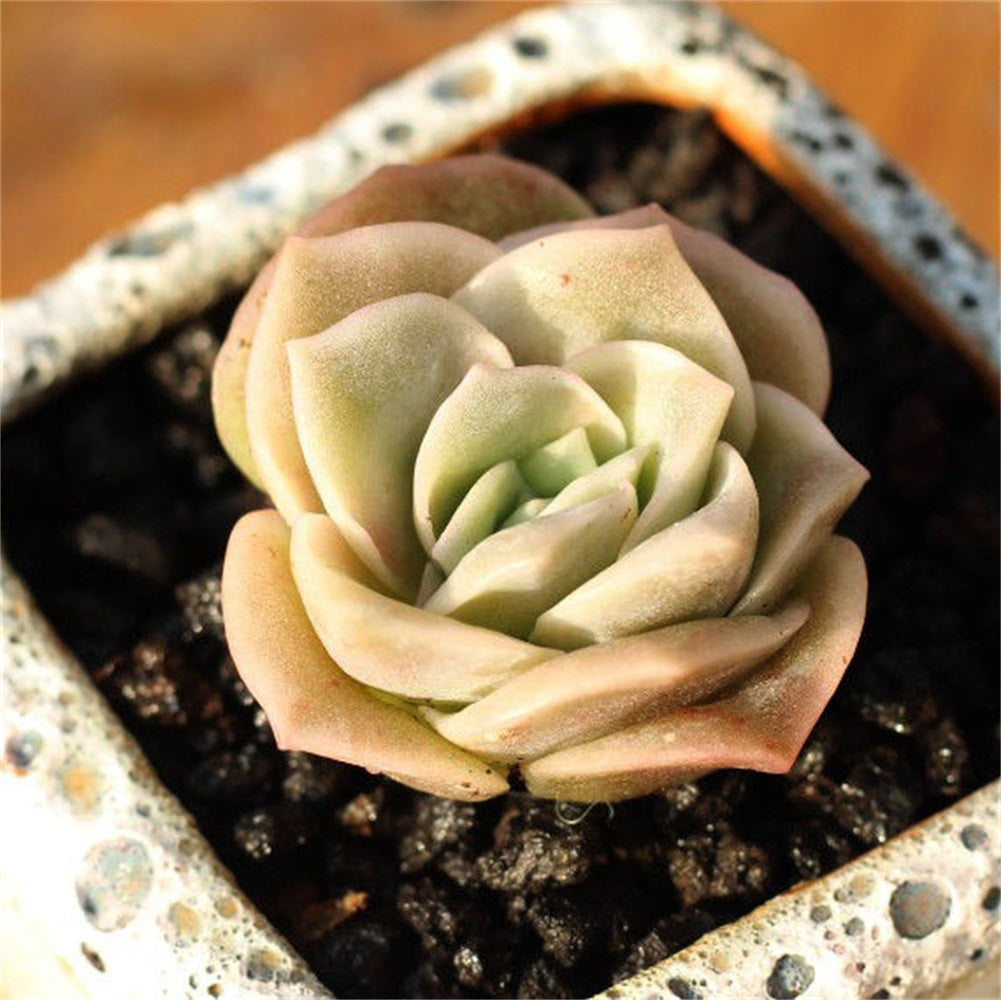Echeveria 'Lovely Rose' are succulent plants of the Crassulaceae family. Their leaves are thick and compact, with slightly upturned edges, making them prone to growing stems but not easily forming clusters. They typically stand alone, resembling roses. Many enthusiasts find them easy to color, but improper care can cause them to elongate and turn green. To address these characteristics, we need to pay attention to the following four points during maintenance.
Soil and Potting:
Echeveria 'Lovely Rose' are petite plants that tend to grow stems, forming upright old stumps. For such varieties, it's best to choose slightly taller pots that resemble vases, giving them a fairy-like appearance when stems emerge later. Personal preference should avoid using short and fat pots, which do not match the temperament of Echeveria 'Lovely Rose'. Besides shape, pots must have drainage holes.
Soil plays a crucial role in the coloring process of succulents. When caring for Echeveria 'Lovely Rose', soil should be tailored to local climate conditions and personal care environments. If ventilation conditions are good and temperatures are suitable, peat soil can be used, resulting in thicker leaves. If conditions are not ideal, increase the proportion of granules to about 40% but not too high before forming old stumps.
Light and Watering:
Watering Echeveria 'Lovely Rose' should be adjusted according to sunlight conditions. While many enthusiasts fear overwatering, Echeveria 'Lovely Rose' prefer relatively more water. Excessive water control can cause plants to become smaller and lose their color. Apart from controlling watering during high temperatures in summer, as long as there is sufficient sunlight, it's acceptable to keep the soil slightly moist during other seasons. Seeing stems doesn't necessarily mean elongation; Echeveria 'Lovely Rose' naturally love to grow stems as long as the leaves remain firm, it's normal. In autumn and winter, with adequate sunlight and temperature differences, charming purple-pink colors will appear, which is adorable.
Being fond of water does not mean watering without moderation; excessive watering can result in waterlogged stems with poor hardness, causing them to tilt. Placing a bamboo stick in the pot can control soil moisture, preventing waterlogging. Dealing with elongated Echeveria 'Lovely Rose' can be troublesome. Additionally, watering is related to soil composition; many enthusiasts have switched to using high-grain soil, which drains well but often results in root dehydration and wilting due to infrequent watering.
Clustering and Old Stumps:
The most significant feature of Echeveria 'Lovely Rose' is that they are not easily clustered. After about three years of care, some may produce lateral buds. Typically, to create a clustering effect, they are planted together in a pot, with 2-5 stems per pot, resembling a bouquet when stems emerge. By this time, most stems have lignified, and their vitality is strong. Watering can be reduced appropriately, and the proportion of granules can be increased to control growth. It's easier for them to color but difficult to control their growth during this period, so be firm in maintenance.
Many enthusiasts choose beheading to encourage Echeveria 'Lovely Rose' to grow multiple heads. If they are not elongated excessively, beheading is not recommended. Beheaded clusters appear awkward and unnatural; it's better to create a "pseudo-cluster" through potting. If beheading is necessary, apply fungicide afterward, place them in a shaded area, and gradually increase sunlight when the lateral buds are strong enough.
Propagation and Fertilization:
The survival rate of leaf insertion for Echeveria 'Lovely Rose' is very high. As long as intact leaves are selected and placed gently on the surface of the soil, rooting and sprouting can occur within 7 to 15 days under suitable temperatures. Leaf insertion can be done at any time above 10°C. When inserting leaves, keep the soil surface moist; slight humidity helps root growth, while appropriate sunlight benefits new leaf growth. As for fertilization, twice a year is sufficient, preferably in early spring and late summer. Both liquid fertilizer and slow-release granular fertilizer can be used, but regardless of the type, less is more to avoid root damage, which is not worth the risk.
